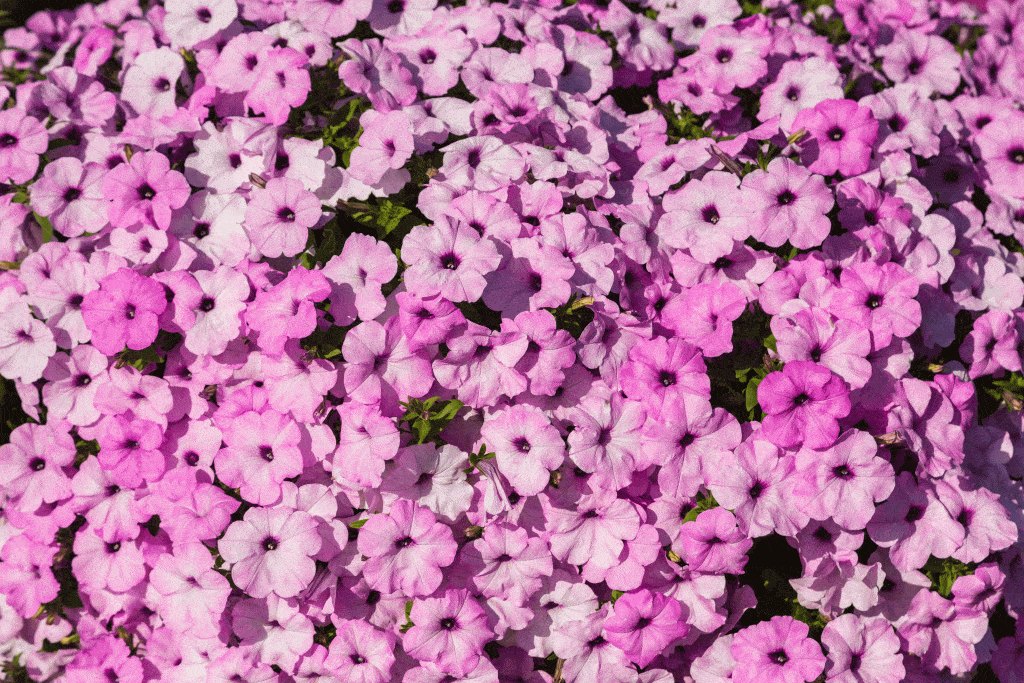 Petunias are one of today’s most popular flowering perennials, even though they are often treated as annuals. They come alive each spring with bright, bold blooms that burst with delightful, air-filling fragrance. There are hundreds of petunia varieties that grow beautifully all summer long. Right now, you may be wondering to yourself, ‘do petunias spread?’
Petunias are one of today’s most popular flowering perennials, even though they are often treated as annuals. They come alive each spring with bright, bold blooms that burst with delightful, air-filling fragrance. There are hundreds of petunia varieties that grow beautifully all summer long. Right now, you may be wondering to yourself, ‘do petunias spread?’
Ground cover or spreading petunias, such as the ‘wave’ variety, are only about six inches tall, but they can spread very quickly, covering a large garden area in a single growing season! Abundant watering and regular fertilizing will make them spread even more, that’s why it’s important to properly and frequently prune the plant.
Now that you know petunias are a ‘spreading’ flower, let’s take a closer look at this in more detail below. We will discuss whether or not all petunias spread, which types tend to spread more and should they be cut back each year. So, if you’re ready to learn more about spreading petunias, then let’s get started!
Do Wave Petunias Spread?
Wave petunias are a specific type of flower that is fast-growing and can fill in large garden areas due to its ‘spreading’ ability. For this reason, they need to be planted farther apart (twelve to twenty-four inches) in warm, wet, fertile soil.
Purple Wave petunias are hybrids that can four to six inches tall and spread two to four feet. They provide excellent ground cover for walkways and large flower beds. Other similar varieties include the Pink Wave, Rose Wave, Coral Wave, and Misty Lilac Wave petunias.
Tidal Wave petunias grow into bush-like formations that either climb or cascade, depending on where they are grown. A single plant can extend up to six feet high with a spread of three feet or more! Other types include Easy Wave, Shock Wave, and Avalanche petunias.
Do All Petunias Spread?

Not all types of petunias spread like wave petunias. Grandiflora petunias, for example, have large blooms, up to five inches across. They do well in contained areas such as window boxes or hanging baskets and do not require a large space in which to grow or spread.
Multiflora petunias are smaller and denser. They have strong stems that can withstand wind and heavy rain better than grandiflora petunias. They grow well in pots or hanging baskets and do not need space in which to spread, like wave petunias.
Milliflora petunias are low-maintenance, bloom early and produce a mass of flowers for such a miniature-sized plant. They grow best in pots or hanging baskets and may spread slightly, but not near as much wave petunias.
Wave petunias need to be planted in the ground in a large area, such as a garden. When grown in full sunlight, they are so full of flowers that you can barely see any foliage! They have a unique trailing growth pattern and will spread rapidly if properly maintained.
How Much Do Petunias Spread?
Petunias spread at different rates depending on the variety and planting location. Often referred to as ‘trailing’ petunias, wave petunias can spread several feet if they are sown in a large, open area such as a garden or outdoor floor bed. Most other petunia types will only spread slightly, if at all, especially when grown in pots, hanging baskets or window boxes.
Do Petunias Come Back Every Year?
Petunias are perennials, however, they are typically treated as annuals. In year-round warm climates, they will often survive and even bloom over the winter months. If you live in a cooler climate and want your petunias to grow back in the spring, then you must store them indoors during the winter.
Should Petunias Be Cut Back?

In order to prevent ‘leggy’ petunias, you need to cut them back on a regular basis. Wave petunias especially need to be pruned as they can grow very thick and spread quite far. For best results, start pruning as soon as the flowers are planted. It is easy to do and goes a long way in maintaining the health and longevity of the plant.
The steps for properly pruning wave or spreading petunias include the following:
- Check your petunias once a week and clear away any fallen deadheads from the soil surface.
- Pinch and remove any deadheads or wilted blooms still remaining on the plant.
- Trim stubborn deadheads with pruning shears – clip just below the bud of the flower near the stem.
- Cut off sinking stems to half their height, leaving at least two inches of stem from the base using pruning shears – this encourages regrowth.
- Trim any limp or damaged stems down to two inches away from the base of the plant.
- Cut down 1/3 of your plants every second week by removing the bulk of the stems while leaving at least two inches at the base for regrowth.
- Water the soil just enough so that it is damp, not wet.
- Apply an all-purpose fertilizer sparingly once a week to the soil using a 10-10-10 solution consisting of nitrogen, phosphorus, and potassium.
Choose Wisely, Depending on Your Petunia Needs
In summation, not all petunias are the ‘spreading’ or ground-covering type. Spreading or ‘Wave’ petunias are only about six inches tall but can extend very quickly, covering a large garden area in just one growing season. Frequent watering and fertilizing will make the flowers expand even more. Therefore, it is important to maintain your plants with proper and frequent pruning.
Good luck and happy gardening!
